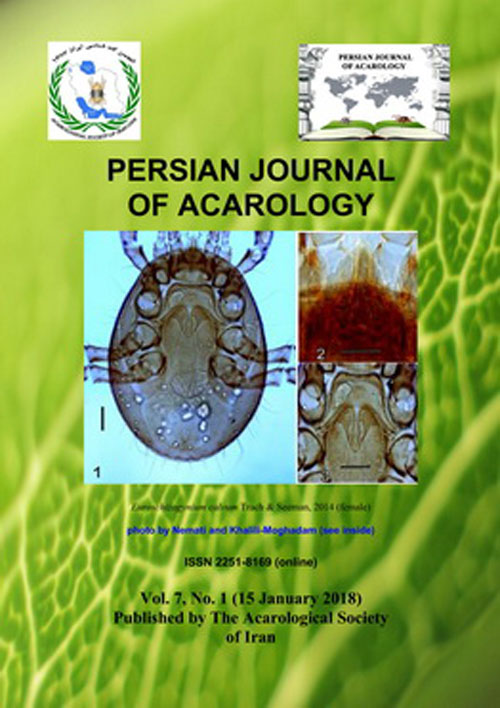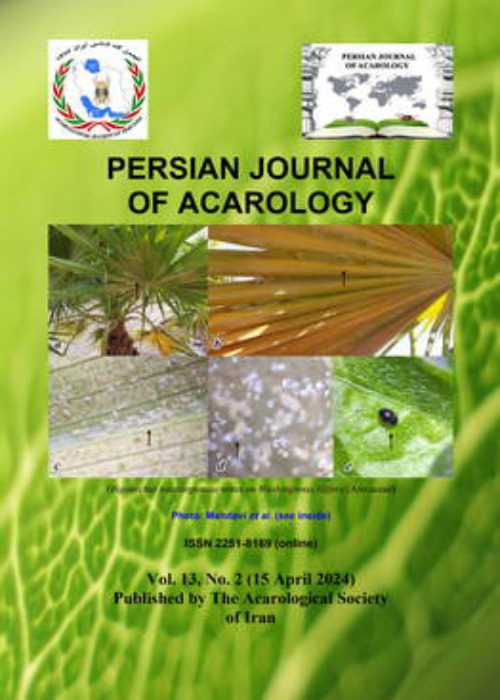فهرست مطالب

Persian Journal of Acarology
Volume:7 Issue: 1, Winter 2018
- تاریخ انتشار: 1396/11/15
- تعداد عناوین: 8
-
-
Page 1The larva, protonymph and deutonymph of Hemipteroseius indicus (Krantz & Khot, 1962) are described from specimens collected on the red cotton bug, Dysdercus sp. (Hemiptera: Pyrrhocoridae) in India and Democratic Republic of Congo. These are compared with the characteristics of the adult female. In addition, the complete chaetotaxy of the dorsal and ventral idiosoma and some details of the gnathosoma and legs are given. These are compared with the published details of Hemipteroseius adleri, H. womersleyi, Nabiseius duplicisetus, Noctuiseius treati, and Prasadiseius cocytes representing four genera and six species of Otopheidomenidae. Five tables and many colored figures with details, including a pharate female and a pharate male, are included.Keywords: Immature stages, motile, Otopheidomenidae, pharate, Pyrrhocoridae, red cotton bug
-
Page 41Lasioerythraeus saboorii Khanjani, Raisi & Izadi was described and illustrated based on larvae ectoparasitic on Aphis punicae (Passerini) (Hemiptera: Aphididae) from Boshrouyeh, Ferdows city, South Khorasan Province, Iran. In this paper, additional specimens were collected on unknown species of Chloropidae (Diptera) as host from Mahvelat City, Khorasan Razavi Province and additional metric data are provided. A revised key to world larval species of Lasioerythraeus is presented. Chloropidae is reported as a new host for the genus.Keywords: Acari, Acariformes, Prostigmata, Mahvelat City, Khorasan Razavi Province
-
Page 51Varroa destructor Anderson & Truman is the most serious pest of honey bee colonies all over the world. Its specimens were assessed by morphometric and geometric morphometric methods using six morphometric traits including body length and width, length and width of the right metapodal shield, length of epigynal and the anal shield for classical morphometrics and six landmarks in ventral surface of mite's body, in seven provinces including Ardabil, Markazi, Qom, Qazvin, Alborz, North Khorasan, and Semnan. Twenty and ten individuals were used for morphometric and geometric morphometric studies, respectively. The ventral surface of each mite slide was prepared and used Digimizer and Tps package software for morphometric and geometric morphometric measurements, respectively. Data were analyzed with Past software. Furthermore, principal component analysis (PCA) was used for both two methods. In addition, Cluster analysis was used to categorize specimens of provinces. The results demonstrated significantly morphometric and geometric morphometric (or shape and size) differences among the specimens of provinces. Qazvin and Ardabil were located in one group with the PCA and Cluster analysis in the classical morphometric method and Alborz mite's dimensions showed a significant difference in morphometric measurements with other provinces. However, in the geometric morphometric method, Ardabil, Markazi, North Khorasan, and Semnan specimens were located in another group. The difference in distribution can be related to geographical factors and methods of measurement.Keywords: Cluster analysis, geometric morphometrics, morphometrics, PCA analysis, varroa mite
-
Page 61In order to increase their inclusive fitness, animals predominantly probe their changing environment for predation cues to adopt appropriate antipredator strategies and decrease the costs of defensive behavior. Intraguild predation (IGP) occurs when a predator kills and consumes individuals of another predator which is its competitor for a shared prey. IGP is prevalent among predatory mites of the family Phytoseiidae which are used as biological control agents of agricultural pests worldwide. Phytoseiid mite mothers usually display antipredator behaviors to avoid or reduce IGP risk of their juveniles. When facing a novel IGP risk, experience may enable the mothers to display more efficient antipredator responses. We studied the effect of experience on reciprocal antipredator behaviors of an indigenous predatory phytoseiid mite, i.e., Neoseiulus barkeri Hughes, and an exotic one, i.e., Amblyseius swirskii Athias-Henriot, as biological control candidates for integrated pest management strategies in Iran. First, we determined the occurrence of IGP and mutual risk of the predators within the guild; IGP occurred reciprocally and A. swirskii was the stronger IG predator. Second, in choice situations between a patch with only shared prey and a patch with shared prey plus IGP risk cues, we scrutinized patch choice, oviposition site selection and ability to counterattack by females of each species that had either experienced the IGP risk or not. The experience did not affect patch choice and oviposition behaviors of the species whereas it elicited an increase in their predation on IG predator juveniles. We suggest that the presence of IG predator juveniles and cues may not significantly modify the distribution of the IG prey species. The reinforced counterattack behavior in experienced females showed that both species were able to tune their antipredator behavior after exposure to IG predators. Consequences of the antipredator behaviors in experienced IG prey females on distribution and possibilities of the coexistence of the study species are discussed.Keywords: Antipredator behavior, predation risk, predatory mites, role reversals, biological control
-
Page 75Recently incidence of Tetranychus urticae is a widespread issue in grape orchards in India. The possibility of a pesticide induced resurgence of mites was explored by applying field recommended doses of commonly used pesticides. The field trial revealed no resurgence with respect to dicofol, abamectin, spiromecifen, dichlorovos fish oil resin soap and dinocap usage consecutively. Sulphur induced heavy resurgence (16.55%) with resurgence ratio of 1.05, followed by thiamethoxam (8.89%), acetamiprid (6.97%), imidacloprid (6.15%) and buprofezin (5.46%) with resurgence ratios of 0.81, 0.89, 0.87, and 0.88 respectively.Keywords: Abamectin_dichlorovos + fish oil resin soap_dicofol_dinocap_pesticides_resurgence_spiromecifen
-
Page 85Poultry red mite, Dermanyssus gallinae De Geer (Mesostigmata: Dermanyssidae), is an important pest of birds in avicultures and it is an economic, hygienic and epidemiologic problem in the poultry industry. Uses of botanical pesticides are good and safe alternatives instead of chemical compounds. In the present study acaricidal and repellency activities of Conocarpus erectus, Portulaca oleracea and Pistacia atlantica extracts were evaluated against D. gallinae by calculation LC50 value and repellency index of each herbal extract in laboratory conditions and were compared with abamectin (a conventional chemical acaricide). However, all herbal extracts had less toxicity against the mite than abamectin. Aquatic and ethanolic extracts of C. erectus exhibited repellent for D. gallinae. The repellency effect was not observed in P. oleracea and P. atlantica extracts. Therefore, based on this experiment, it could be concluded that the aquatic and ethanolic extracts of C. erectus can be used as a safe botanical acaricide and repellent compound for control of D. gallinae in avicultures.Keywords: Birds, botanical acaricide, Conocarpus erectus, Portulaca oleracea, Pistacia atlantica, repellent
-
Page 93Q fever, as one of the tick-borne zoonotic diseases, is caused by Coxiella burnetii. Ticks may play an important role in C. burnetii transmission to animals and humans. By using nested Trans-PCR, we investigated the presence of C. burnetii in ticks collected from dogs in Kerman, southeast of Iran. A total of 375 ticks were randomly collected from 100 dogs. Eight pools were finally formed. The pools of tick samples were assessed for the presence of C. burnetii. Genomic DNA extraction was done and samples were evaluated by nested Trans-PCR. All tick specimens were identified as Rhipicephalus sanguineus regarding the taxonomical characteristics. Coxiella burnetii was detected in 1 out of 8 (12.5%) pool samples. One positive sample was subjected to sequence analysis, which successfully confirmed the accuracy of the PCR assay. Our data show that ticks infesting dogs can be infected by C. burnetii, providing zoonotic importance of these populations. Efforts should be focused on understanding the role and epidemiologic importance of dogs and their ticks, especially for human Q fever, which can be a life-threatening disease.Keywords: Genomic DNA extraction, nested Trans-PCR, Q fever, Rhipicephalus sanguineus, zoonotic disease
-
Page 101
In addition to the female genital structures, the most Trigynaspida is diagnosed by the following combination of characters in the adults: presence of eight setae on femora IV, absence of an unpaired postanal seta, presence of the setae av4 and pv4 on tarsi IV, presence of four anterolateral setae (al) on tarsi IIIV, absence of salivary styli in gnathosoma and presence of hypopharyngeal styli in gnathosoma (Kethley 1977; Kim 2004). So far seven species belonging to six trigynaspid families have been reported from Iran: Asternoseiidae, Antennophoridae, Celaenopsidae, Cercomegistidae, Diplogyniidae and Schizogyniidae (Kazemi and Rajaei 2013, Kazemi and Paktinat Saeej 2013, Nemati et al. 2014). The Schizogyniidae Trägårdh, 1950 a poorly known family (Ryke 1957; Kinn 1966; Karg 1977) was recorded for the first time from Palearctic region by Nemati et al. (2014). This family includes only six genera and eleven species (Ryke 1957; Kinn 1966; Trach and Seeman 2014) with the following morphological characters: usually having latigynial plates fused with ventral shield (except in Mixogynium); ventral shield broadest posterior to coxae IV; metasternal shields separate, fused with sternal shield or fused together into a single plate; anal plate free or fused with ventral plate; metapodal plates usually represented by large shields (except in Mixogynium), free or fused with peritremal plate (Kinn 1966; Trach and Seeman 2014).
In this survey mites were separated around mouth parts of carabid beetles, Scarites sp. (Coleoptera: Carabidae) that have been deposited in Entomological Collection, Plant Protection Department, Agricultural College, Shahid Chamran University, Ahvaz in 1998. Mites were cleaned in Lacto-phenol, mounted in Hoyers medium and deposited in Acarological laboratory, Plant Protection Department, Agricultural College, Shahrekord University, Shahrekord (APAS). Study was done using Olympus microscope equipped with phase-contrast and digital camera. Measurements are given in micrometers (µm).


